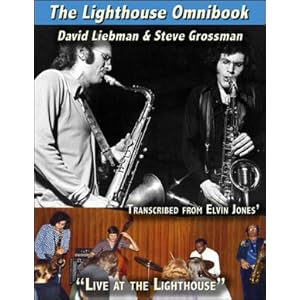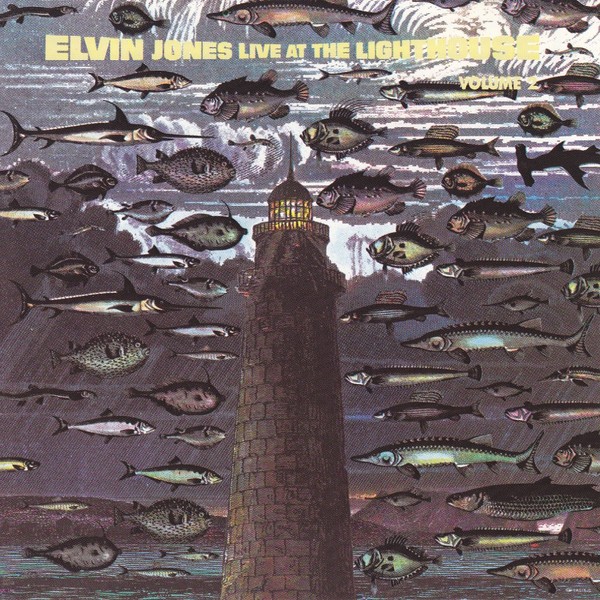Uma gravação de grande importância histórica já que, apenas passados 3 anos da morte de Coltrane, é neste grupo que se começa a vislumbrar por onde seguiria a herança do Mestre.
Dois dos mais convictos e extraordinários saxofonistas pós-coltraneanos - David Liebman e Steve Grossman - deixam neste disco pegadas que muitos outros iriam seguir nos anos que se seguiram.
No final deste post, um video recentemente chegado ao youtube (final de 2011) com excerto de um concerto deste grupo.

Both of us were students of the great master saxophone teacher in New York, Joe Allard, who had certain concepts related to the use of the vocal cords for playing as an extension of singing/speaking, so there were definitely saxophonic similarities to be sure. On both soprano and tenor, Steve’s time feel was usually quite even while I tend to break up the rhythm more. Steve’s tone on tenor was a bit brighter than mine and more nasal on soprano. Both of us had a few licks that we played a lot but I often liked to use the saxophone’s natural facility to intervallically skip around a bit. Steve’s tenor altissimo sound (above the natural range of the instrument) was more tightly squeezed than mine. However both of us liked to use our vocal cords to support the sound in that register rather than just tightening the embouchure, which was a more common technique. Harmonically and rhythmically I was more prone to playing away from the expected mode or pulse, but when we played together which happened quite a bit especially at the end of tunes (an influence from our free jazz encounters in the New York lofts), we both moved quite outside the given framework.
Of all the tracks on the Lighthouse recording, the one that most saxophonists comment on is Donald Byrd’s "Fancy Free" which has long phrases of Dorian modes to play over. Steve and myself play a lot of sixteenth notes in and out of the key center while Elvin and
Gene basically hold to a quasi-bossa nova, with some dramatic and intense fills at the end of each chorus. Both of us play extremely intense and furiously. I think that to capture this kind of energy on record was somewhat rare in those days outside of Miles and Trane recordings that we all knew from the ‘60s (Birdland, Village Vanguard, Plugged Nickel, etc.) and may have contributed to the lasting impression this music has to this day. Before the out melody with Elvin heating up the intensity even further, we go at the scales in tandem. The tune itself has a memorable melody and accompanying figure.
In "New Breed" I solo first and must admit on this track in particular, there are more similarities between Steve and myself than usual. I play quite a bit of double time lines revealing some influence from Charles Lloyd with whom I had studied a few years earlier, especially when I use portamento (slides) in the upper register. After a solo by "Gates" (Gene), we take the melody out revealing tight ensemble work, which we had achieved by this juncture in the band’s development.
Perla’s "Sambra" sets up an intriguing drum pattern by Elvin under my very rhythmically oriented tenor solo. His drum pattern, devoid of the cymbals, is so unique that it defies description. Steve takes the chord changes into swing and burns it up. At this tempo, Elvin often liked to play a little bit on top of the time, which lends a surging quality to the music. Elvin takes a long and intense solo before going out.
One of the hippest tunes we played was the line "Taurus People" by Farouq Dawud. A quick sixteen-bar melody with some nice chord changes sets up Steve, followed by myself for some straight-ahead, burning eighth-note jazz in which Elvin never lets the intensity down. You can hear some smooth off-the-beat hi-hat maneuvers by him at times during the tune.
Meant primarily as a bass feature, Gene’s "Sweet Mama" gave him an a cappella section before Steve enters with open blowing, loosely centered on A minor. I follow in a similar vein with an abundance of harmonics, flurries and altissimo playing before Elvin solos. Just to note, on the surface it may appear to the casual listener that his drum solos are quite similar. But where the differences are is dependent upon which motif he gets involved in as well as the particular combination of drums used. Sometimes he emphasizes the snare, or the hi-tom and snare, or both toms. The rhythms are invariably broken down and displaced throughout the set with the bass drum often serving a purpose similar in function to a comma or period in prose writing, as a temporary pause.
Playing a ballad with Elvin meant dealing with a few specific drum matters. First of all, the nearly silent scraping of the snare drum for the melody chorus meant the beat was quite soft so you needed to rely heavily on yourself and the bass for the pulse. This was also true when soloing because of the manner in which Elvin double timed, and on occasion, dramatically slapped the drum with the brush or as he was prone to do, incorporating long cross rhythmic motifs and hemiolas. Add to this, the requisite a cappella cadenza both, as an intro and outro and one can understand the challenge of playing a ballad with Elvin. My ballad feature in the band was "I’m A Fool To Want You." I enjoyed this plaintive bluesy melody and the way it sounded especially in the tenor upper register, reminiscent of an old Trane ballad from the '50s. The intensity of Elvin’s mallets under my cadenza would make me have to reach deep down inside myself to come up with something
"The Children, Save The Children" was written by a friend of Gene’s, Don Garcia, and features Elvin at his laid back best, keeping the groove happening while I go first on soprano with Steve following on tenor. This is a good example of the master keeping the reins on the pot while the "young bloods" are blowing their heads off. This happened often with Steve and myself. We would immediately play everything we knew and Jones would just hold the whole dynamic down as if to say: "What are you so excited about?" This would definitely cool us off. Steve’s solo is typical of his great ability to shift between fast, over-the-pulse lines and laid back eighth notes, one of Trane’s outstanding characteristics during the late '50s and early '60s in the "sheets of sound" period.
"Brite Piece" opens with Steve soloing first on tenor alternating lyricism and chromatics, along with in and out of the pulse rhythms episodically contrasted. Beginning much in Steve’s vein on soprano, I also move in and around the stated pulse. With comments from both of us during the Latin bridge section used as backgrounds and Gene’s interactive rhythmic figures with Elvin, one immediately senses that group conversations were an important component of this band’s sound.
A dramatic introduction with arco bass brings in Elvin’s thunderous marching beat and variations for this nearly thirty minute version of "The Children’s Merry-Go-Round March". Here I begin on tenor staying close to eighth notes in open harmonic territory with eight-bar phrases as the basic framework. After Steve joins in with me, he continues in a similar vein turning up the rhythmic heat by mixing in and around pulse oriented lines continuously. My re-entry furthers increases the intensity with both of us honking on multiphonics and reverting to a little whole tone scale line of Steve’s. In fact, this section is an abridged version of a lot of the music we had played together in the lofts. The free jazz movement of the 1960s did in fact have a big effect upon us. Basically it involved a lot of communal, group playing without key centers or steady time and almost always in high energy. It was great for us that we could incorporate a little of that with Elvin who was open to what we had to bring to the table. What is probably one of the longest recorded drum solos in jazz follows and is a textbook primer on how Elvin constructs and deconstructs motifs while building to climaxes and then seemingly beginning again with another idea. His solos have an internal logic all their own as a result of this motif-building process.
 Playing the blues at a slow tempo with Elvin is an experience all musicians should have experienced at least once in their life. This feeling is embodied in Gene’s "For All The Other Times." Steve begins the twelve bar exchanges for this version which is abbreviated here as a set closer. The last chorus with Elvin’s "strip tease" backbeats is exhilarating followed by a thunderous final cadence.
Playing the blues at a slow tempo with Elvin is an experience all musicians should have experienced at least once in their life. This feeling is embodied in Gene’s "For All The Other Times." Steve begins the twelve bar exchanges for this version which is abbreviated here as a set closer. The last chorus with Elvin’s "strip tease" backbeats is exhilarating followed by a thunderous final cadence.
The
Live At The Lighthouse date was one of the most exciting nights of my musical life. The energy and enthusiasm of a working band consisting of three young musicians with one of the greatest masters of all time was for all of us a once in a lifetime event that we will never forget. It’s fantastic that it was captured on tape.
NOTES ON TRANSCRIPTIONS
Thanks to the amazing transcription work done by Norwegian saxophonist Petter Wettre along with Gene Perla’s diligent follow up, I can add a sentence to the above: "it’s fantastic that it was captured on tape AND ON THE PAGE AS WELL!" Pedagogically speaking, I am a big advocate of transcribing when done at a high level, meaning that the chosen solo is worthwhile and that the student accomplishes what is called for, which is most importantly playing the solos note for note, nuance for nuance. Important musical aspects revealed in a solo usually pertain to matters of phrasing (attack, nuances, dynamics, time feel, etc.), besides the obvious pitches themselves, all of which are just not obtainable by any other method except exact imitation. Of course, I would encourage the reader to get the original recording of these Lighthouse solos and attempt to play along with them. But on a more practical level, these solos can be used like an encyclopedia to examine something you heard on the recording. If a phrase stirs your imagination, use the music to isolate the notes and analyze as best you can what was happening. Always remember to match the phrasing also, not just the pitches in order to truly reflect the feeling of the music.
We hope you enjoy this book of the solos from the Lighthouse. Have fun—we certainly did!!
August 27, 2005 "

Comentários